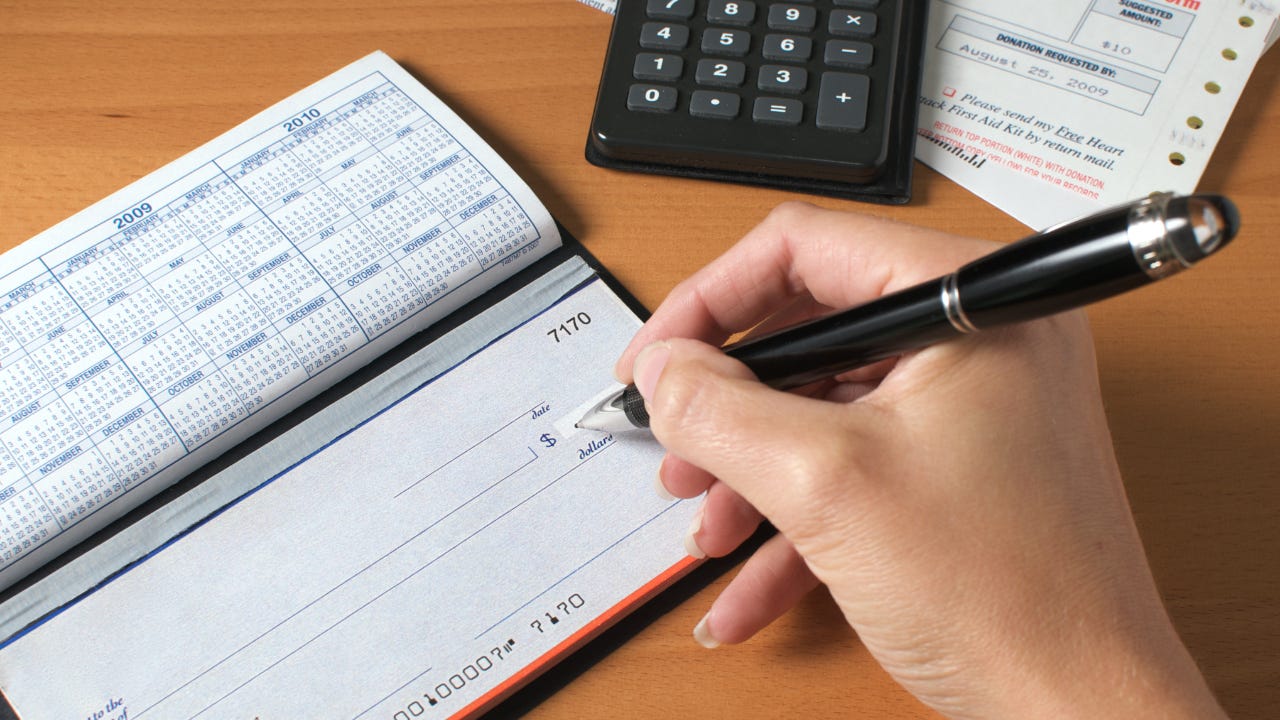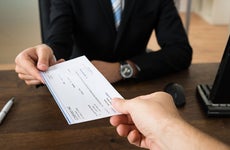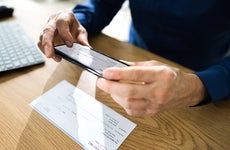What is a bounced check and how do you avoid it?

The Bankrate promise
At Bankrate we strive to help you make smarter financial decisions. While we adhere to strict , this post may contain references to products from our partners. Here's an explanation for .
Our writers and editors used an in-house natural language generation platform to assist with portions of this article, allowing them to focus on adding information that is uniquely helpful. The article was reviewed, fact-checked and edited by our editorial staff prior to publication.
Writing a paper check to make a payment is safer than carrying around lots of cash. But if a check bounces, it can be expensive and awkward, especially if you know the payee.
Here is a detailed look at why checks bounce and how you can avoid making that mistake.
Key takeaways
- A bounced check can result in various negative financial consequences such as penalty fees, overdraft fees, outstanding debts and a damaged banking reputation.
- There are several reasons why a check can bounce, but most commonly it’s due to insufficient funds in the payer’s bank account.
What is a bounced check?
A bounced check is a check for which there aren’t enough funds in the bank customer’s account to cover it. The bank declines to honor the check and “bounces” it back to the account holder, who is typically charged a penalty fee for nonsufficient funds (NSF).
A bounced check is sometimes called a “rubber check.” There are other factors that cause checks to bounce, but lack of funds is the most common one.
When a check bounces, the payee doesn’t receive the intended funds, resulting in financial consequences for the check-writer.
What happens when a check bounces?
Several things can happen when a bank account holder bounces a check. Here are six consequences.
Nonsufficient funds (NSF) fee
When you don’t have enough funds to cover a check, your bank likely will charge you an NSF fee. The average NSF fee, according to Bankrate’s 2023 checking account and ATM fee study, is $19.94.
Overdraft fee
In some cases, if you write a check without enough money in your account to cover it, your bank might decide to cover the amount for you. This is known as an overdraft. However, the bank will then charge you an overdraft fee, which is $26.61 on average, according to Bankrate’s study.
Bounced checks and penalty fees can snowball quickly and put an account holder in a financial hole, so it’s important to get your finances under control as quickly as possible.
Outstanding bills
When a check bounces, the payee doesn’t receive the promised funds. Let’s say, for example, you write a check for your monthly rent. If there isn’t enough money in your account to back the check, the landlord doesn’t receive your payment.
Besides the bank penalties you incur, you will have an outstanding debt to your landlord until you can pay the rent.
Other penalty fees
Besides NSF or overdraft fees charged by your bank, the payee might penalize you, too. The landlord who got the rubber check for your monthly rent could charge you a penalty.
If you’re late with a payment, such as to a utility or lender, because the check bounced, you’ll likely be charged a penalty, especially if it’s not your first time. Financial institutions such as credit card companies often forgive penalties for established customers with excellent payment histories.
Damaged banking record
ChexSystems is a consumer reporting agency that helps banks and other financial institutions assess a potential customer’s reliability.
ChexSystems keeps a record of your banking behavior. If you have a history of bounced checks, unpaid fees and forced account closures, your ChexSystems report will reflect that.
Banks look at the ChexSystems reports of their account applicants. If your report is blemished, a bank may deny your application. Consumers in this situation may have to apply for a second-chance checking account until they can qualify for a traditional account.
Closed bank accounts
If you bounce enough checks, your bank could freeze or close your account. Talk with a bank representative if you are having trouble managing your account.
The bank may be more willing to work with you if it sees that you earnestly want to fix the problem.
Why do checks bounce?
There are several causes of bounced checks.
Insufficient funds
“The most common reason for a check to bounce is when there are insufficient funds to cover the check amount,” says Salvador Gonzalez, accounting and management professor at Walden University.
If you write a check for $1,500, but you have only $1,000 in the bank, it will bounce when the payee tries to cash it because you don’t have enough funds to cover the amount written on the check.
You’ll probably pay a penalty fee to your bank for writing a rubber check.
Stale date
A check can bounce because “the check is considered ‘stale’ or ‘stale-dated,’ which refers to the check not being cashed within typically six months,” explains Jacob Dayan, a partner at Consumer Law Group in Chicago.
Banks aren’t required to cash checks that are more than six months old. If you write a check and the payee puts it in a drawer and forgets about it until seven months later, you may have to write the payee a new check.
Ask your bank about its procedures for handling stale checks. If it believes the check will clear, it can go ahead and process it, but it’s not required to after six months.
Check not filled out correctly
If a check has incorrect or missing information, it could bounce. A few details to double-check before handing a payee a check include:
- The date on the check is correct. It’s important to know that banks are allowed to process post-dated checks before the date on the check, so be sure you have sufficient funds in the account when you write the check.
- The numbers and words for the check amount match. The check amount is written on the check twice, in numbers and words. Be sure the two amounts match.
- The check is signed in the right place by an authorized signer on the account.
Knowing how to properly fill out a check helps you avoid errors that can cause a check to bounce.
What to do if you bounce a check
If you’ve bounced a check, don’t panic. Here are three ways to resolve it:
- Contact your bank and the recipient immediately: Open and honest communication can help alleviate some of the potential negative outcomes associated with bouncing a check. Make sure to pay any bank fees incurred, so they don’t accumulate.
- Make payment arrangements: If possible, quickly cover the owed amount to prevent the bounced check from turning into an outstanding debt.
- Consider alternative payment methods: If you find yourself frequently close to overdrawing your account, consider using other payment methods such as electronic transfers, debit cards and peer-to-peer payment apps.
Remember, knowingly writing checks without sufficient funds can lead to legal repercussions. It’s always better to be safe than sorry when it comes to managing your finances.
How to avoid writing a bad check
A bounced check is an expensive error. Not only can your bank penalize you, the payee might do the same. There are a few ways to keep checks from bouncing and avoid NSF fees.
- Add overdraft protection to your account. This is an optional service that many banks offer their checking account customers. With overdraft protection, the bank covers a check if you don’t have enough money in your account. Banks charge a fee for this feature and there are usually limits on check amounts.
- Add a linked account. By linking your checking account to a savings account or other source of funds, money can be transferred from that account to your checking to cover a transaction and keep your balance from going into the red.
- Set up account alerts. Use your bank’s mobile app to receive instant notifications of a low balance and other account activity.
- Monitor the account closely. Check your balance often, make sure checks clear and automatic deposits show up.
Bottom Line
Bouncing a check can have financial consequences, such as penalty fees, but there are steps you can take to avoid writing a bad check. These include staying vigilant about your account balance, considering alternative payment methods and adding safeguards such as overdraft protection and linked accounts.
— Bankrate’s René Bennett updated this story. Sarah Sharkey wrote a previous version of this story.
Related Articles


What is a cashier’s check? Definitions, uses, how to buy one, cost and alternatives

